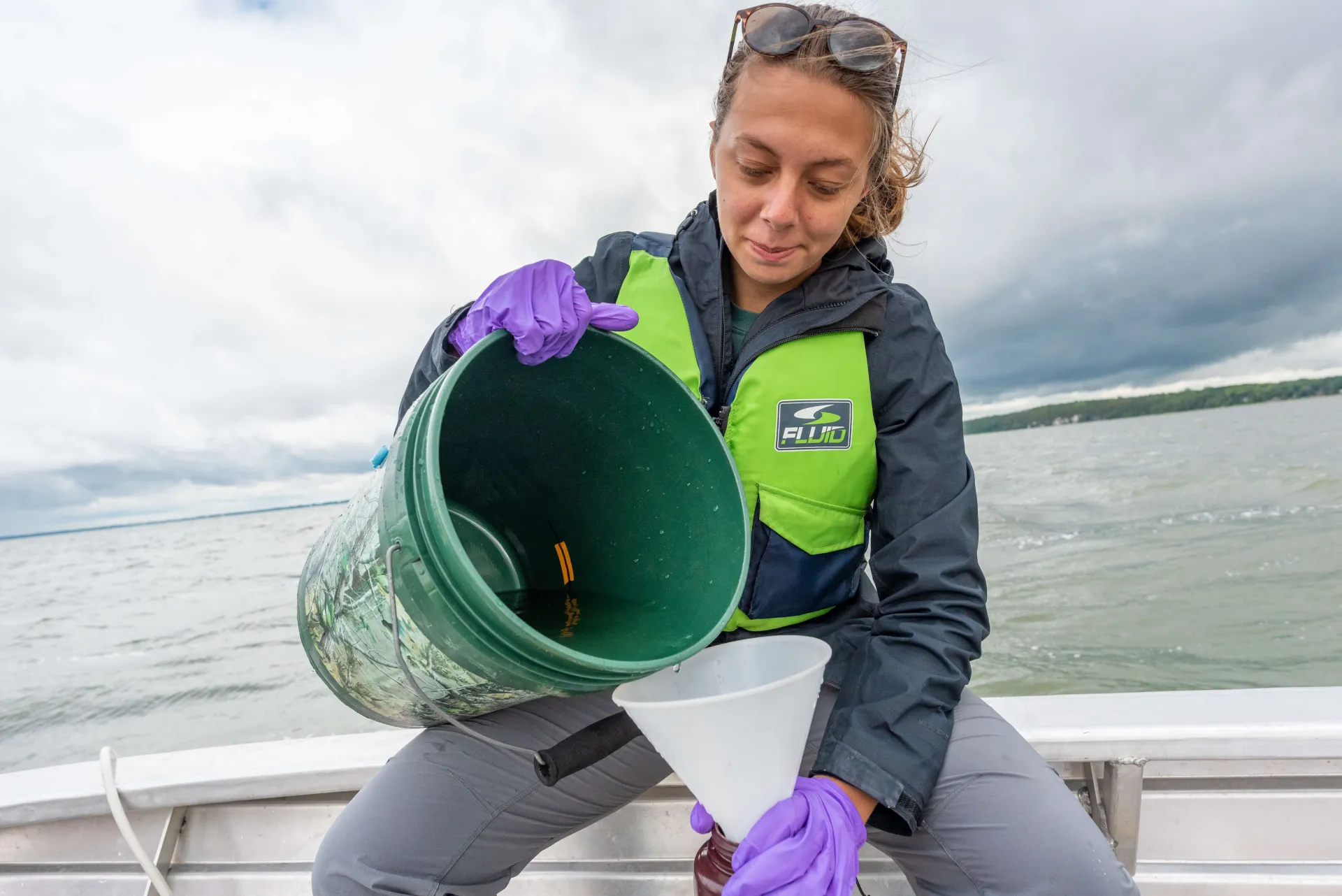Nitrogen is a bit of a conundrum. In its gaseous form it’s the most abundant element in the atmosphere, but few organisms can readily use it. And while all living organisms contain nitrogen, a new University of Vermont study finds that even tiny amounts of nitrogen can fuel cyanobacterial blooms and disrupt lake ecosystems.
“When we think about lakes, and we think about production, and what fuels cyanobacteria, there has been a historical lens that it's a phosphorus problem,” says Katelynn Warner, lead author of the study published in the Journal of Limnology and Oceanography, who received her Ph.D. in 2024 at UVM's Rubenstein School of Environment and Natural Resources. “But I think our work shows that it's more than just that.”
Historically, excess phosphorus has been the culprit behind many cyanobacteria blooms in Lake Champlain, prompting occasional beach closures and spurring monitoring efforts. This new UVM research underscores the importance of understanding the role nitrogen plays in generating toxic algae blooms, too.
Cyanobacteria is one of the oldest life forms on the planet. They are photosynthetic organisms that belong in aquatic environments. The problem is when cyanobacteria, often called blue-green algae, populations get out of balance. This can happen when runoff laced with phosphorus and nitrogen enters a lake system. Cyanobacteria use these nutrients to reproduce exponentially creating blooms that choke off sunlight and oxygen from fish and other life forms in the water. They become especially dangerous when they are caused by cyanobacteria species that produce toxins harmful to humans and wildlife.
“Blooms are not ubiquitous, they are not the same every time,” Warner says. “There are different things that lead to toxin production and bloom development.”
During her doctoral studies at UVM, Warner examined the environmental factors driving cyanobacteria blooms and the severity of toxin production in Lake Champlain. In 2021, with a team of UVM researchers, Warner collected weekly water samples in St. Albans Bay and Missisquoi Bay to test for phytoplankton, cyanotoxins, and nutrient loads. They used high-frequency buoys equipped with sensors to capture complete water column profiles every 15 minutes, including oxygen and pH levels, water temperature, turbidity, and meteorological readings such as wind speed and air temperature.
The data lets scientists know on very short time scales what is happening in the basin and gauges activity during cyanobacteria blooms that weekly monitoring may miss, Warner explains.
“Blooms are not ubiquitous, they are not the same every time. There are different things that lead to toxin production and bloom development.” - Kate Warner
Because St. Albans Bay and Missisquoi Bay are shallow and connected to two different watersheds, the scientists could analyze how different lake dynamics affect bloom development. The study focused on two common cyanobacteria species found in the lake—Microcystis and Dolichospermum—and screened samples for various cyanotoxins. While they found low concentrations of toxins during blooms, there were differences in biomass likely triggered by small amounts of nitrogen entering the system.
“We saw nitrogen in Missisquoi Bay being in some cases double of what was in St. Albans Bay,” Warner says. “And that could lead to this strong difference in bloom biomass, potentially because they have those extra nutrients to grow.”
Like all life forms, cyanobacteria compete over limited resources. They specialize in fixing precious nutrients such as phosphorus and nitrogen from the air and water. Some have adapted to store excess nutrients, including nitrogen from the atmosphere. But this is a costly endeavor.
“It takes a lot of energy to do, but it can position themselves to have a competitive advantage to grow [when favorable conditions occur],” Warner explains.
More than a phosphorus problem
Picture a snow globe. When undisturbed, the snow settles at the bottom until the water inside sloshes, mixing particles throughout the water. The same concept applies to sediment in lakes. Only when conditions change—either through temperature, wind speed, or a deluge of water—the sediment and nutrients it holds churn throughout the water column and feed cyanobacterial blooms. Often the culprit propelling these blooms is excess phosphorus.
“We don’t pay as much attention to nitrogen as we need to in water management and lake ecology, and it is very important in determining not always bloom initiation, but the composition of the bloom, the toxicity of the bloom, and how long it’s going to last,” says Ana “Mindy” Morales, an associate professor at UVM’s Rubenstein School of Environment and Natural Resources and co-author of the paper.
Scientists can more easily predict how phosphorus will affect lake systems but less so with nitrogen, she says. “We really need to understand the importance of nitrogen and not just in basic science, but it needs to be translated to management and action—and it’s hard.”
That is in part because nitrogen is so volatile. It naturally occurs in different forms and is synthetically manufactured for industrial and agricultural purposes. Interestingly, over the decades, nitrogen levels have dropped in the northeast arm of Lake Champlain Since 2009, however, nitrogen levels have increased, with the strongest upticks in recent years—likely the result of floods washing more nitrogen into systems, says Warner.
But as their study demonstrates, it doesn’t take much nitrogen to wreak havoc on a lake.
“If a little nitrogen comes in with these big storm events, that can have pretty significant impacts on the ecology of the lake,” Morales says. “We just need to think more critically about how we manage for nitrogen—because we are not really addressing it.”
In deeper portions of Lake Champlain, the water stratifies into layers that mix twice a year, in the spring and the fall. Shallower waters, such as Missisquoi Bay, are more susceptible to mixing due to wind activity. This churning can feed blooms or crash them depending on lake conditions and the timing of cyanobacteria bloom formation. Heat waves or extreme rainfall—events predicted to increase in Vermont with climate change—can exacerbate blooms, too.
“We just need to think more critically about how we manage for nitrogen—because we are not really addressing it.” - Ana "Mindy" Morales
“Cyanobacteria like stable calm conditions,” explains Morales. “But if you have these repeated pulses and mixing events, it can keep them in an exponential bloom phase where things just keep circulating and giving them more nutrients and stabilizing and circulating.”
Next steps
Despite high levels of biomass produced during cyanobacteria blooms, UVM scientists found low concentrations of toxins. While this is good news, it doesn’t mean the water is necessarily safe for swimming.
“Just because we didn’t find toxins in the screen sampling events, it doesn’t mean these blooms aren’t toxic and really dangerous,” Morales cautions.

Warner plans to return to UVM for postdoctoral study to answer some unresolved questions. She will use both high frequency and biweekly sampling from four sites along Lake Champlain to better understand how nitrogen affects bloom cyanobacteria production and toxicity. She aims to determine if the dominant bloom formers in Lake Champlain are even capable of producing cyanotoxins.
“You can have strains of those species that have the ability to produce toxins, and other ones that don’t, but you can’t tell the difference just by looking at them,” Warner says. “You can have two colonies of the same species that look morphologically identical … [but] you have to go into the DNA and target those genes to see if they have those in their genome.”
Warner will use genetic testing to identify which species of cyanobacteria are present, what genes they have, and which are being expressed under various environmental conditions. She will also conduct lab experiments to learn what happens with changes in temperature and nutrient loads. Some cyanobacteria might drop out of the population while others thrive. Consider her work in Missisquoi Bay: Toxins weren’t detected in the initial bloom; but once the large bloom crashed, toxins were found in secondary bloom.
“Is it some other species that is also in this bloom with them?” Warner wonders. “Are there other nutrients or other factors that limit that toxin production?”
And lastly, how can we manage these harmful blooms?
